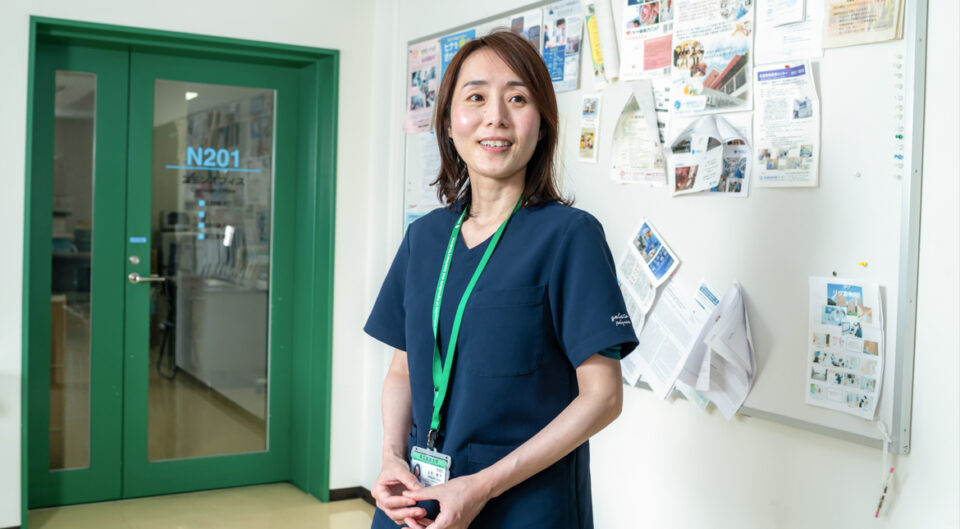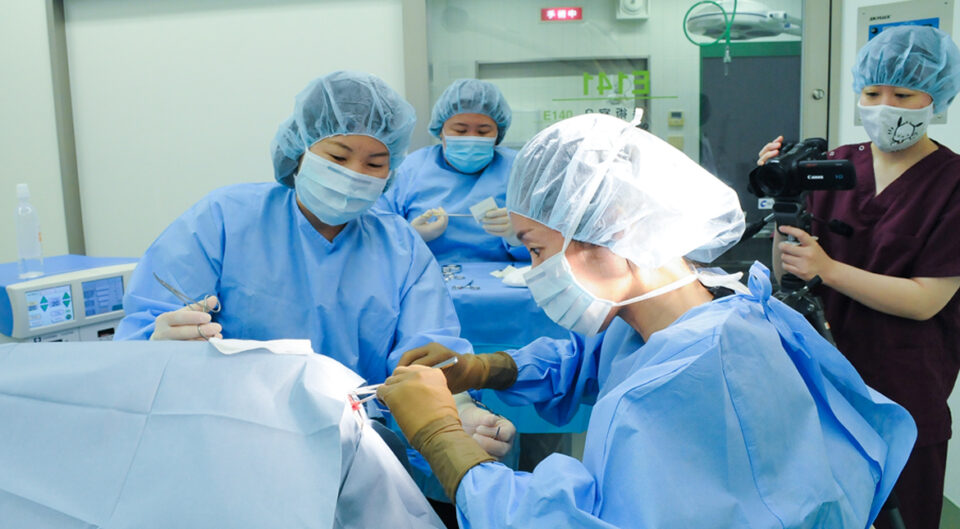
The name “Obihiro University of Agriculture and Veterinary Medicine’s School of Cooperative Veterinary Medicine” may evoke images of veterinary medicine for industrial animals such as cattle, horses, and pigs based on the name in general, as well as the popular image of the Tokachi region where the university is located. The University (OUAVM) has continually contributed to the region as an advanced veterinary medical center in eastern Hokkaido, not only for industrial animals, but also for companion animals, which are treated as full-fledged family members.
OUAVM Associate Professor Akiko Uemura says, “Immediately after I joined OUAVM, companion animal owners who brought sick animals to the OUAVM Veterinary Medical Center amazed me by saying that they had driven from as far away as Kushiro, for example. These owners considered it perfectly normal to drive 140 km from Kushiro to Obihiro, a distance that would take one across one prefecture into the next, were one traveling near Tokyo. This experience made me realize not only how vast Hokkaido is but also how high the expectations of companion animal (pet) owners are about the medical care we provide.” Dr. Uemura’s main areas of research are soft tissue surgery and circulatory organs of dogs and cats.
Veterinary surgery is generally divided into two broad categories depending on the part of the body to be treated. One is soft tissue surgery, Dr. Uemura’s field of specialization, which is concerned with soft tissues, including the circulatory system and other internal organs. The other category is hard tissue surgery, or veterinary orthopedics, which is concerned with organs of locomotion, such as the bones, ligaments, and nerves.
“However, most important is the field of family veterinary medicine, vets who readily provide health advice mainly for dogs and cats, who are precious family members. At OUAVM, we hope to always be available for consultations on diseases that go beyond the capacity of family vets,” says Dr. Uemura.
The same is true of human medicine. There is no telling how reassuring it is to know that there is a medical institution nearby we can turn to whenever advanced medical care becomes necessary.

What cases require advanced medical care? As an example, Dr. Uemura cites cases requiring stent treatment. A stent is a small tube, usually made of metal mesh. In human medicine, it is inserted into the body to keep passages like blood vessels, the trachea, esophagus, and intestines open to counteract narrowing of these passages. Dr. Uemura treats canine tracheal collapse using a newly developed stent she has been quick to introduce.
Tracheal collapse is a disease whereby the trachea (windpipe) narrows or collapses while breathing. Since animals with tracheal collapse cannot breathe properly, they are distressed when they reach the vet. To treat them, Dr. Uemura uses a newly developed tracheal stent. Compared to conventional stents, the new uniquely woven nitinol (alloy) type has excellent trackability (tissue conformability) upon implantation. Since postoperative complications are reduced, this stent is garnering high expectations as a minimally invasive treatment method.
The phrase minimally invasive means “causing less damage to the body during surgery and other treatments” and is interchangeable with the term intervention. Stents, which Dr. Uemura cites as an example, are among the medical devices used for the diagnosis, treatment, and prevention of disease.
She remarks, “Small-breed dogs and cats, which are lightweight, have low circulating blood volume and thin blood vessels. I have therefore studied treatment methods employing device implantation without performing open-heart surgery for small animals with heart disease that require surgery, because such methods cause less burden on the body than open-heart surgery using a heart-lung machine.
“Through minimally invasive treatments and the research and development of new devices, I hope to apply the fruit of our efforts towards benefitting other researchers, as well as dogs and cats and their owners.”
“I often liken veterinary medicine to pediatric medicine. Like babies, who cannot communicate with words, veterinary patients cannot talk or understand what is going on. It is therefore absolutely essential for vets to communicate with the patients’ “parents”, i.e., owners, says Dr. Uemura with a twinkle in her eye.
She continues, “Some people say that their poor interpersonal communication skills caused them to aspire to become a vet.” I think this is a wrong idea, because to get an accurate diagnosis of a patient who cannot talk, one has to communicate with the owners. Veterinary medicine needs more (not less) interpersonal communication than human medicine.”
She also remarks that veterinary medicine has much in common with human medicine.
“Many technologies and devices used in human medicine have been applied to veterinary medicine. Conversely, there are cases in which veterinary medicine provides fundamental insight into human medicine. I hope to go beyond the traditional framework of veterinary medicine and human medicine to collaborate with researchers in various fields, including engineering, pharmaceutical sciences, biomaterials sciences, and life and environmental sciences.”
Dr. Uemura, who had aspired to become a vet since childhood, says that working as a surgeon is not easy, whether in veterinary or human medicine. Despite her words, she is passionate whenever she talks about the future of veterinary medicine.
“To be sure, it is a hard profession, but a fulfilling one, probably because of the joy the hard work brings. It is fulfilling to see animals that have completed treatment happily leave our center with their owners. Such a feeling of fulfillment motivates me to aim higher.”
While treating companion animals, Dr. Uemura adopts ever-evolving advanced technology and research findings in the treatment she provides. Based on such advanced expertise, she envisions the bright future of veterinary medicine, which constitutes protecting these precious family members. As she says, veterinary medicine for companion animals is a truly fulfilling field for her.






